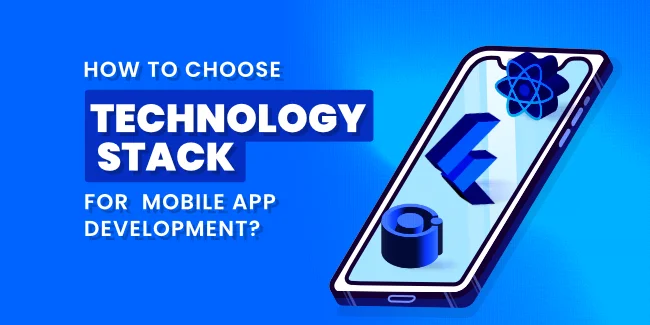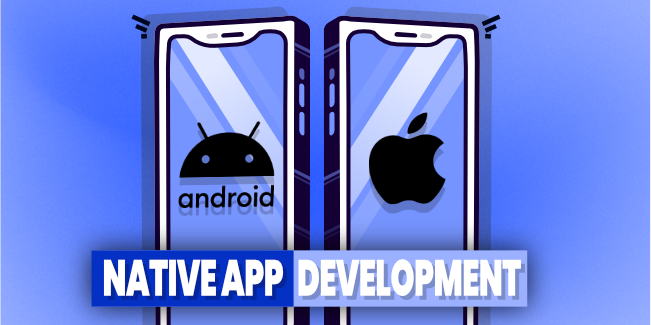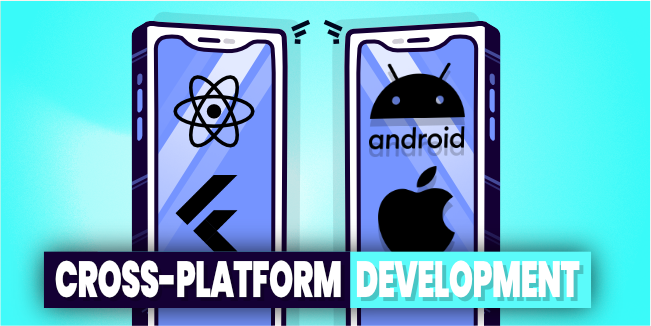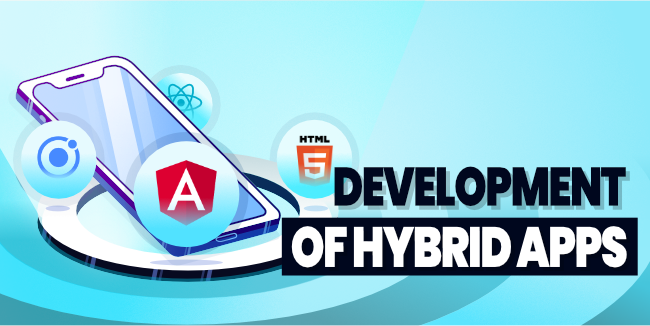Mobile Development
Technologies
development
mobileapp
appdevelopment
techstack
Mobile App Development Technology Stack - What's the best? How to choose one?

Being a mobile app development company, you must be prepared for difficult decisions. Choosing the appropriate mobile technology stack is critical for making your mobile application development project profitable and successful. The technological structure gives your project a pulse and helps you maintain it, expand it, and adhere to your functional requirements. Using an appropriate mobile technology stack may achieve lower costs and less time.
What is a Technology Stack?
The phrase mobile development stack or mobile stack refers to the set of programming languages, platforms, frameworks, tools, UX/UI software, and other technologies required to create a functional smartphone app.
The mobile stack may be broken down into the following elements:
Frontend
The technologies are utilized to create a user interface that communicates with end-users. The frontend is the user's primary interface with an app, and it's what they see. The application of developer skills to a mobile app backend is known as backend development. Understanding the many platforms and tools available for frontend app creation is essential so you can complete any project.
Frontend developers must balance performance and accessibility when working on a new project. There are many different sorts of mobile devices, each with its characteristics to consider.
Backend
The tools and software required to run the server's underlying processing. Backend development is a crucial component of mobile apps that aids data storage, functionality, and security. An app's backend, like the server of mobile apps, sorts and keeps all critical information inaccessible to end-users. In general, not all applications require a backend, but more and more apps include the backend as part of their standard development process.
Development
It's a combined platform that brings together the elements necessary to create an app. A development platform is a type of software that allows businesses to create, test, and deploy their items in a short amount of time.
The development platform may be built by yourself, but most businesses choose to acquire third-party solutions. Frontend development tools, mobile backend as a service, and API management tools are among the most popular offerings from these products.
Others
Different tools and methods enhance the app's security, flexibility, and performance.
What to Consider When Choosing a Technology Stack?

During mobile app development, you have many technologies to select from. Which one is the finest option for your mobile applications?
If you want to create good, functioning software and something more like maintainability, scalability, and security, it's critical to have a sound strategy in place when selecting a mobile app stack.
There are several variables to consider while selecting the proper mobile application technology. The following are the most important factors to think about.
Project Type
It's critical to choose the mobile application development technology stack that is right for your project.
If you want to develop a sophisticated mobile app with exceptional performance and a unique platform-specific user interface implementation, then go native. In such circumstances, developers use Kotlin or Swift as the most common languages.
Choose a cross-platform approach if you're a startup and want to test your product concept, engage potential consumers, and stay one step ahead of the competition.
React Native is a fantastic option, for example, since it is cost-effective and allows you to reuse code across platforms, allowing for broad platform coverage and rapid app delivery.
Idea Validation
The process of validating a concept through experimentation to make fast, informed, and de-risked judgments are known as idea validation.
Idea validation aims to put the concept through its paces in the real world before you create and offer the final product or service. It begins with a business idea and can eventually result in a paying customer. You can validate your idea during the workshop.
The Idea Validation stage is much more complex than it seems and, in fact, is one of the most important stages of software development projects. That is why you shouldn't skip it.
Development Time
The speed at which businesses can bring new products to market is essential for maintaining a competitive advantage.
Consider using a framework with many ready-made solutions for everyday development tasks, such as authentication and social media integrations, if you want to improve the rate at which you develop your product.
Tech Stack Approaches
As we mentioned, many proven approaches exist to choosing the right mobile development tech stack. Before making this fundamental choice, it is worth knowing what options we have to choose the one that best suits our needs.
Why is it essential to make the right decision? You can't select a mobile development stack and expect to create an end product. As a result, in the early phases of development, you must first decide on the app's features, the budget you will spend on it, and the anticipated user experience. You must also learn the technology stack alternatives that might fulfill these requirements to make an informed decision.
The mobile app stack may hint at your program's ultimate strengths and limitations, even if it's just in terms of performance. Therefore in the process of choosing a tech stack for mobile app development, business owners have different paths to choose from that in the future will dictate not only the functionality of their products but also their popularity.
Native Mobile App Development

Native mobile app development is performed with platform-specific programming languages, development tools, development environments, and other utilities provided by operating system vendors. As a consequence, creating native applications for several platforms necessitates the use of distinct mobile app development technologies for each. Lyft and Pokemon GO are examples of popular native applications.
The two most dominant mobile platforms on the market are Android and iOS. What to consider when choosing mobile development technologies? Let's take a deep dive.
Tech Stack For iOS Apps
Making it simple, iOS app development relies on the use of two primary programming languages:
Objective-C
iOS applications are created in Objective-C, an object-oriented programming language developed by Apple. It also has a dynamic runtime environment and excellent object-oriented programming quality. Because it is more difficult to use, developers prefer Swift instead.
The following are some of the reasons why many mobile app development firms still prefer Objective C:
- A language that has already been used and proven to be effective;
- It is still considered easy to use;
- The syntax for expressive message;
- APIs are simple to use for personal usage;
- Third-party libraries are multifaceted;
- C++ compatibility is very high;
- Greater access to Apple's technologies.
Because Apple has begun to favor Swift, the popularity of Objective-C is declining as it makes it easier for developers to develop sophisticated products fast and simply.
Swift
Swift has no string identifiers, resulting in fewer mistakes. It consumes less code and is simpler to learn, debug, and modify than other languages. Swift is expected to be the most widely used programming language by 2021, owing to its readability, speed, and simplicity. The attractiveness of Swift is due to several causes:
- A programming language with new, useful features;
- It supports many devices with ease;
- It includes a growing and active user base;
- The source code is easier to read;
- Simple to maintain;
- Contains a large number of dynamic libraries;
- It provides a significant boost in performance and speed.
Because of its user-friendliness, Swift's code is gaining in popularity, which has prompted many organizations to start employing Swift developers.
Toolkit or SDK?
To develop an iOS app in Swift, you'll need Apple Xcode as the development toolkit. This powerful development environment allows you to create mobile apps and desktop programs. Integrated Git support, a graphical designer for user interfaces, instrumentation and debugging tools, and integrated documentation are all included with Xcode.
On the other hand, the iOS software development kit (SDK) includes an application programming interface (API) that connects software programs and the platform they are running on. APIs may be created in various ways and include useful programming libraries and other tools. The iPhone SDK provides tools for Apple's touchscreen interface and its proprietary iOS operating system, which is used to run Apple's iPhones and Apple's other mobile devices, such as the iPad.
Tech Stack For Android Apps
Android applications are frequently created in one of two languages:
Java
The most common Android app development language is Java, which has many advantages for making Android application creation easier. It's based on the Android API and other Android applications. Its pros are:
- Definitely scalability and portability;
- Automated memory management;
- A more rapid build process;
- Good support from the development community.
A big disadvantage of Java is that it is a languid language that uses a significant amount of RAM.
Kotlin
Kotlin is less popular and weighs less than Java. It's not a specialized language for doing specific activities in the scientific community. It was created specifically for Android app development. Furthermore, it is fully compatible with the Java Virtual Machine, allowing developers to utilize either framework when developing a mobile app.
Kotlin is clear, precise, and safe compared to other programming languages. It is good in reducing the chance of making errors, and of course, it supports complete Java interoperability. Also, it has a feature that allows for slow loading. Because Google has declared Kotlin as the suggested language for Android application development, it enjoys broad adoption among developers.
Android Studio or ADT?
The Android Studio IDE includes code editing, debugging, performance tooling, a versatile build system, and an immediate build/deployment technology. It allows you to concentrate on creating one-of-a-kind and high-quality applications.
You may develop Android apps with the aid of Android Developer Tools (ADT). In addition to providing Android-specific programming help, ADT allows developers to utilize on-device debugging tools, a graphical user interface builder, emulators, and fully scriptable test automation functionality.
If you want to know more about native app development, you should take a look at our article on this topic. There we explain what exactly it means and show its benefits and drawbacks.
Cross-platform Development of Apps

Your app needs to be adaptable to run on various platforms. Cross-platform development entails using a single code base and developing mobile apps for multiple platforms simultaneously, with adaptations made to most devices. Cross-platform mobile apps are made with a variety of frameworks. Let's look at some of them.
React Native + JavaScript/TypeScript
React Native is a JavaScript framework for developing mobile applications that appear and function similarly to native applications for both iOS and Android. React Native uses the same essential user interface components as regular iOS and Android applications. You need to combine the pieces using JavaScript and React.
React Native is a new, unique, and efficient method for creating user interfaces. Your application logic is written in JavaScript, while your app's visuals are native. Instagram and Skype are two excellent examples of such applications.
Xamarin + C#
Xamarin is a cross-platform mobile app development solution that lets engineers write and share 90% of code across multiple platforms. C# is the primary language used in Xamarin's cross-platform programming.
C# is a statically typed language with well-established development tools and support. C# apps are compiled to native Android and iOS executables. Integrating device-specific APIs and features directly into C# code is also feasible. Slack, for example, is created using Xamarin.
Development of Hybrid Apps

Hybrid development employs standard web technologies and tools, such as HTML5, CSS, and JavaScript. The shared code is then wrapped in a native container using different tools and delivered as a regular app. Such applications operate similarly to websites, albeit with some of the features of an app combined. Let's look at the current hybrid app development platforms and see how they work.
Cordova/PhoneGap
Apache Cordova is free, open-source software that allows you to develop mobile apps using HTML/JavaScript. JavaScript APIs expose native device features, allowing HTML-based applications to utilize device-specific capabilities such as sensors and cameras.
Fortunately, HTML and CSS are not the only tools developers can use when building a user interface. PhoneGap supports a variety of frameworks and libraries, including jQuery, AngularJS, and Knockout.js.
Ionic
Ionic is an AngularJS-based framework that shares many features with the well-known framework. Ionic reuses DOM elements to minimize one of the causes of poor mobile performance, which is something it similarly does in React Native. The ability to create hybrid apps that have a native appearance is also effectively demonstrated.
A Few Tips
So that your application has a much better chance of success, the first step forward is to stay updated with the mobile app development trends. Being up-to-date can teach you how to predict the future of the market, which can give you a competitive advantage.
Don't be limited. Closing down on one mobile development technology can have undesirable results. Of course, we previously advised you to choose the right approach to picking a stack mobile, but it only makes sense if you know the pros and cons of others. Native apps are amazingly polished, but cross-platform apps are more likely to be downloaded due to availability, etc.
Conclusion
Mobile apps' popularity will continue to rise as more businesses embrace mobile technologies. Choosing the appropriate mobile app technology stack is critical if you want to build a highly effective mobile app.